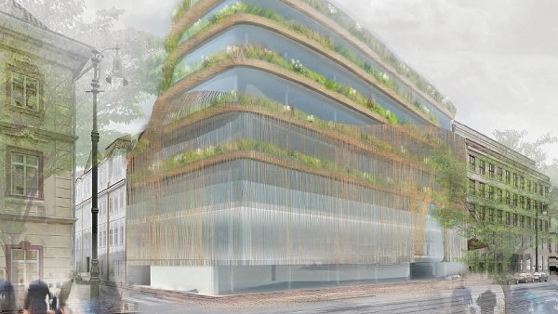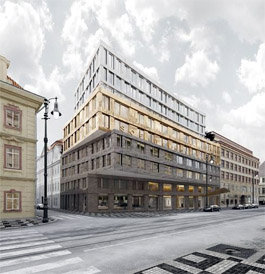
Investor of the project at the corner of Národní has changed both the appearance and the purpose of the project
Source
Karel Čapek
Karel Čapek
Publisher
ČTK
14.03.2014 10:40
ČTK
14.03.2014 10:40
Czech Republic
Prague
Stanislav Fiala
FIALA + NEMEC s.r.o.
 |
| Stanislav Fiala / Fiala + Nemec, National Palace, visualization |
Prague - The investor of the building at the corner of Národní and Mikulandská streets in Prague has fundamentally changed the appearance and purpose of the project. The planned structure will now feature rounded edges, will be one floor smaller, and its façade will be significantly highlighted by greenery. Instead of a hotel, a multifunctional building is set to rise on one of the most expensive plots in Prague. This was stated by the project's author, Stanislav Fiala.
The investor is now requesting a new zoning and building permit from Prague 1. According to Fiala, the authors have been discussing the proposal with heritage conservationists for some time, who reportedly agree with the intention. Since parts of both plans are similar, construction has already begun based on the building permit issued for the original project.
The changes to the plans came with a change in the ownership of the land. The new investor, Sebre, purchased it along with a valid building permit for a hotel. However, the intention has changed significantly, both visually and in purpose.
The mayor of Prague 1, Oldřich Lomecký (TOP 09), welcomed the project change. According to him, the center of Prague is already overcrowded with hotels. He stated that it is also important for the city district that the inner courtyard will be opened to the public thanks to the passageway. Two floors of shops and services will be created in the building, while the rest will be allocated for offices and studios.
 |
| original plan: Znamení čtyř, hotel, visualization, 2008 |
The project also foresees the reconstruction of the adjacent historically protected Baroque Schönkirch Palace. During its inspection, valuable historical paintings of wooden ceilings from the late 17th century and wall paintings were discovered. They depict various mystical creatures and scenes, battle scenes, or images of cities. What exactly the paintings mean should be revealed by further investigation. According to Fiala, the investor intends to have them restored and made accessible to the public.
"We also value ordinary original building materials such as bricks, limestone stones, wooden beams, pebbles from the old pavement, destroyed wooden parquet, and old, now irreparable tiles," said Fiala. The materials are to be incorporated into further construction. Historical wells could, for example, be preserved as skylights. The project authors are also counting on a wine cellar that could be located in exceptionally well-preserved Gothic cellars.
The construction is accompanied by several technical curiosities. The historical objects in the courtyard area currently stand only on scaffolding made of pipes, which are drilled into a depth of about seventeen meters. Workers are gradually excavating the soil around the structure.
The project cost is likely to approach one billion crowns. In 2005, the city sold the land for what is likely a record price of 234,700 crowns per square meter, totaling nearly 184 million crowns. The hotel was supposed to be built according to a project by the studio Znamení čtyř from 2008.
The English translation is powered by AI tool. Switch to Czech to view the original text source.
Related articles
0
08.10.2014 | Investor may build a glass building instead of a hotel on the National site
0
19.02.2014 | On the corner of Mikulandská and Národní, the research has concluded and construction is beginning
0
09.10.2013 | In the corner of Národní and Mikulandská, a multifunctional building could arise
0
14.02.2013 | After the archaeologists finish their work, construction will begin on the most expensive plot of land in Prague
1
27.01.2010 | The battle for the most expensive piece of land in Prague has begun
4
17.04.2007 | The part of Národní třída in Prague 1 will change its appearance
4
28.02.2007 | New luxury hotel on Národní street will cost 1.2 billion.
1
22.01.2007 | The guardians of monuments do not like the study of the new building on Národní třída
0
03.10.2006 | On the last available plot on Národní street in Prague, there will probably be a hotel











